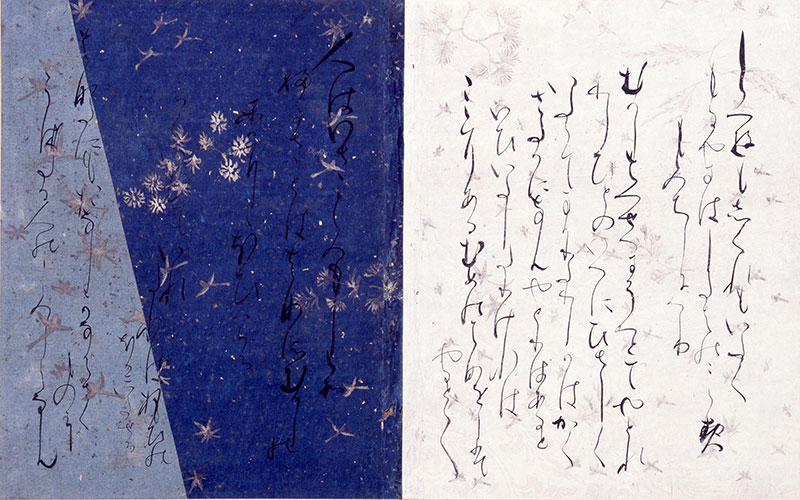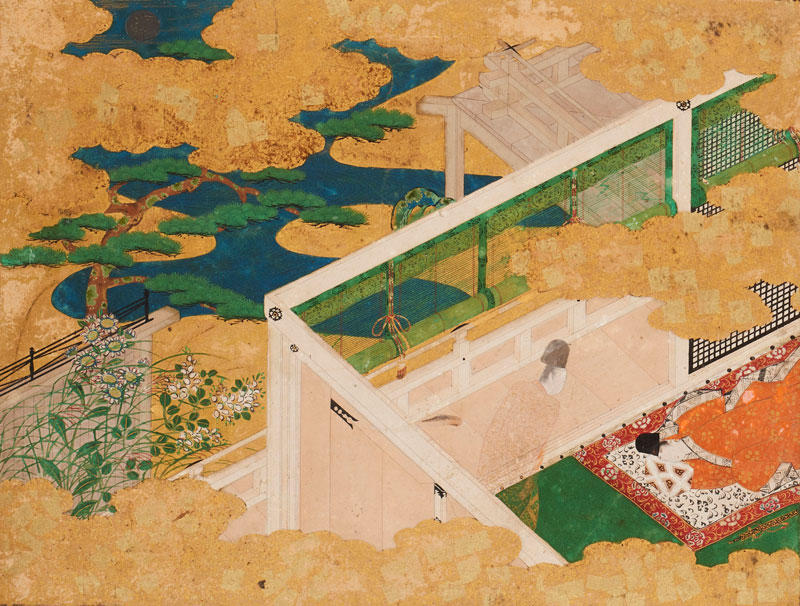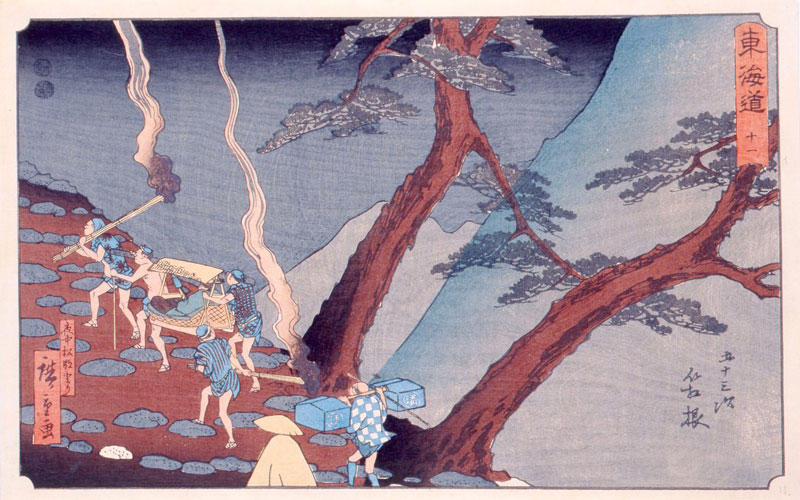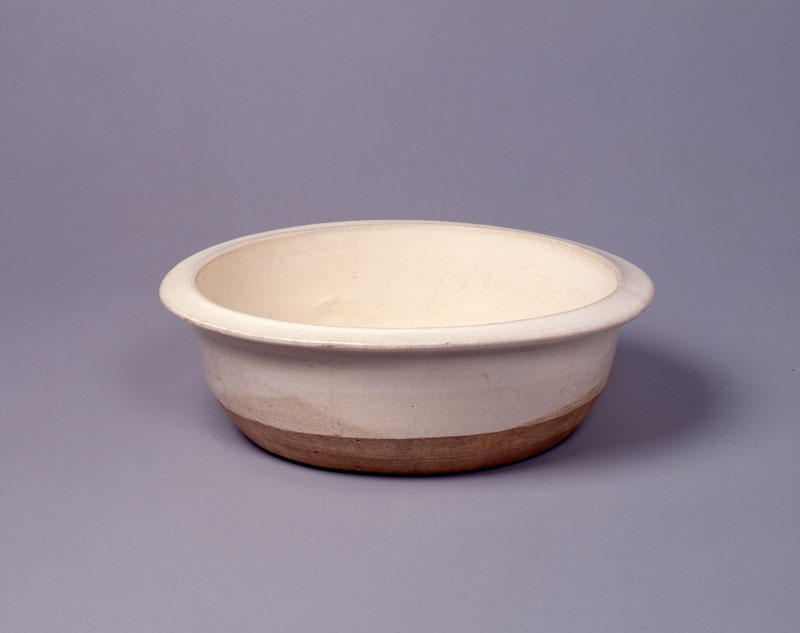2020年度の展覧会
浮世絵師 歌川派列伝―国貞・広重・国芳―
2020年6月27日(土)〜9月6日(日)
江戸時代の浮世絵界で最大流派となった歌川派は、江戸だけでなく上方の地でも活躍しました。本展覧会は、歌川派の祖である歌川豊春から初代豊国、広重の師である豊広の浮世絵をはじめとし、歌川派三羽烏と称された歌川国貞(三代歌川豊国)、歌川広重、歌川国芳がそれぞれ得意とした美人画、風景画、武者絵などを中心に展示します。幕末から明治時代にかけて歌川国芳の下での修行を経て浮世絵師となった落合芳幾や月岡芳年の作品や、上方の地で活躍した歌川広貞、歌川芳梅などの地域縁の浮世絵師たちの作品もあわせてご覧いただきます。
書の名品 ―経巻・墨蹟・和様の美―
2020年10月3日(土)〜11月29日(日)
本展覧会は、当館が所蔵する書の名品を紹介し、その魅力にふれていただこうとするものです。書のみを取り上げて展示する初めての機会となります。奈良時代から鎌倉時代に書写された経巻、鎌倉時代以降の禅僧による墨蹟、国宝「歌仙歌合」をはじめとする和歌を書いた平安時代から鎌倉時代の古筆を主軸として、契沖や富岡鉄斎など和泉や大阪に所縁のある人物の書も含めた、約40点を陳列いたします。
特別出陳として、江戸時代の剣豪・宮本武蔵が描いた水墨画の「枯木鳴鵙図」(重要文化財、前期展示)など、当館の所蔵品を代表する作品もご覧いただきます。※期間中展示替えあり。
東洋のやきもの―日本、中国、アジアの国ぐに―
2020年12月19日(土)〜12月25日(金)、
2021年1月5日(火)〜1月31日(日)
日本、中国のやきものを中心に、アジア各地の作品も加え所蔵品から約80点を陳列いたします。日本は備前など中世の古窯の作品や楽茶碗などの近世の作品、中国は古代の土器から近世の色鮮やかな絵付けの器まで、各時代の特色を見せてくれる作品を陳列いたします。そのほか、朝鮮半島、東南アジア、西アジアのやきものもあわせて公開し、アジア各地の多様な造形をご覧いただきます。器の形、釉薬や文様の美などやきものの魅力をご鑑賞ください。
※年末年始(12/26から1/4)は休館いたします。
物語の中へ―源氏と伊勢―
2021年2月14日(日)〜3月28日(日)
所蔵品の中から、平安時代の古典文学の双璧をなすと称される『源氏物語』と『伊勢物語』に関する作品を選び展示します。この二つの物語は、それぞれ書写され、あるいは印刷されることによって、長く読み継がれてきました。それに加えて、物語のさまざまな場面が、時代ごとに特色をもつ表現形式や意匠によって絵画化されてきたことにより、物語の享受層を広げ、物語の鑑賞を豊かなものにする役割を果たしてきたといえます。
本展覧会では、『源氏物語』と『伊勢物語』をそれぞれに題材にして制作された、屏風や色紙、扇面、版本、浮世絵版画、かるた等、多彩な作品を展示します。物語の中へ誘われ、その魅力に満ちた世界をご堪能ください。
Ukiyoe Masters of the Utagawa School—Kunisada, Hiroshige and Kuniyoshi
June 27 (Sat.), 2020 – September 6 (Sun.) (62 days)
The Utagawa School was the largest of the ukiyoe schools during the Edo Period, and its artists were popular not only in Edo (current Tokyo) but also in Kamigata (Osaka). This exhibition displays masterpieces featuring the subjects of women, scenery and swordsmen by the forerunners of the school: the founder Toyoharu, Toyokuni I, and the famous Hiroshige’s teacher Toyohiro, as well as the school’s top three stars: Kunisada (Toyokuni III), Hiroshige and Kuniyoshi. The exhibition also includes works by Ochiai Yoshiiku and Tsukioka Yoshitoshi, both of whom were taught by Utagawa Kuniyoshi between the late Edo and Meiji Periods, and works by Osaka local artists, Utagawa Hirosada and Utagawa Yoshiume.
*Guided tours are scheduled to be held four times during the exhibition period.
The Tenma Tenjin Festival at Night in Osaka by Utagawa Toyoharu, Edo period
Evening Glow at Nihonbashi, from the series, “8 views of Edo” by Utagawa Toyokuni, Edo period
53 Stations of the Tokaido, Hakone by Utagawa Kunisada, Edo period
53 Stations of the Tokaido, Hakone (Hoeido Edition) by Utagawa Hiroshige, Edo period
The True Loyal Retainer: Oboshi Yuranosuke by Utagawa Kuniyoshi, Edo period

2 Segments of anthology of Tsurayuki’s poems “Ishiyama-gire” codex joined (Important cultural property), by Fujiwara no Sadanobu, Heian period
Calligraphy Masterpiece—The Beauty of Sutras, Writing, and Poems
October 3 (Sat.), 2020 – November 29 (Sun.) (50 days)
This is our first calligraphy-only exhibition, introducing masterpiece items owned by this museum, to showcase the beauty of this kind of art. The exhibition has a display of around 40 items, mainly featuring sutras created between the Nara and Kamakura Periods, calligraphic writing by Zen priests in the Kamakura Period and after, and poems penned between the Heian and Kamakura Periods including the National Treasure “Kasen Utaawase.” There are also exhibits created by those related to Izumi and Osaka, such as Keichu and Tomioka Tessai.
Alongside this exhibition, some signature items from our museum are shown as a special display. These include “Bansei” that was created during Southern Song Dynasty and passed through the hands of both imperial families and those of the Tokugawa Shogunate (National Treasure, exhibited from April 11 to May 6), and “Shrike in Barren Tree” by a Japanese swordsman of the Edo Period, Miyamoto Musashi (Important cultural property, exhibited from April 28 to June 7).
*Guided tours are scheduled to be held four times during the exhibition period.
A Competition comparing coupled poems by Poetic Immortals (National Treasure), Heian period Chapter of Expedient Methods of Lotus Sutra (Important cultural property), Heian period 2 Segments of anthology of Tsurayuki’s poems “Ishiyama-gire” codex joined (Important cultural property), by Fujiwara no Sadanobu, Heian period Hokyoin-darani Sutra (Important cultural property), by Emperor Fushimi, Kamakura period Poems composed at poetry parties during Emperor Go-Toba’s journeys to Kumano by Fujiwara no Norimitsu (Important cultural property), Kamakura period Calligraphy by Yishan Yining (Important cultural property), Kamakura period Poem: A Place Called Shinge of Izumi by Keichu, Edo period Shrike in Barren Tree (Important cultural property), by Miyamoto Musashi, Edo period
Ceramic Ware from the East—Japan, China, and Other Asian Countries
December 19 (Sat.) – 25 (Fri.), 2020 & January 5 (Tue.) – 31 (Sun.), 2021 (30 days)
In this exhibition, we display approximately 80 items of different ages from our collection mainly from Japan and China, with additional works from the Korean Peninsula and Southeast and West Asia. The Japanese items include works from ancient kilns of medieval times, such as Bizen, and early-modern examples such as Raku tea bowls. Chinese items cover those from ancient earthenware to early-modern vessels with colorful paintings. Enjoy the intriguing variety of shapes, glazes, and designs of the selected exhibits.
*Guided tours are scheduled to be held four times during the exhibition period.
Flower vase of ryuko (standing hourglass-shaped hand drum) shape, known as “Tabi-makura”, Ki (yellow) seto type (Important cultural property), Momoyama period
Teabowl, Karatsuware, known as “Sampo” (Three treasures) (Important cultural property), Momoyama period
Celadon vase with phoenix handles, known as “Bansei” (National Treasure), Southern Song Dynasty
Tea bowl, Kohiki type, Yi Dynasty
Iron-painted jar with lid with Baoxiang-hua scroll (hōsōge) design, Thailand, 15–16th Century
Painted pottery jar with beak-like spout, Iran, 10th Century B.C.

The Transverse Flute 2, Scenes from An Album of Illustrated Scenes from The Tale of Genji (Important cultural property), by Tosa Mitsuyoshi, Edo period
Into the World of Classic Stories—The Tales of Genji and Ise
February 14 (Sun.), 2021 – March 28 (Sun.) (37 days)
This exhibition features selected works from our collection that are related to The Tale of Genji and The Tales of Ise, both of which are highly recognized as the top two works of classic literature of the Heian Period. These stories have been transcribed and printed a number of times throughout the ages to be cherished by literature fans. In addition, various scenes from both stories have been adapted as artworks in different forms, styles and designs that signify the time of creation. This has helped attract a wider audience to enjoy the stories in a variety of ways. Items displayed in this exhibition are quite diverse, ranging from paintings on folding screens, paper and fans, to woodblock prints (e.g. ukiyoe and books) and karuta cards. Invite yourself into a world of attractive stories.
*Guided tours are scheduled to be held four times during the exhibition period.
An Album of Illustrated Scenes from The Tale of Genji (Important cultural property), by Tosa Mitsuyoshi, Edo period
The Tale of Genji Album of Illustrations by attributed to Kano Tanyu, Edo period
The Tale of Genji Folding Screen, Edo period
The Tales of Ise by Female Courtier to Emperor Go-kashiwabara, Muromachi period
The Tales of Ise, the Saga Edition by Suminokura Soan, Edo period
The Tales of Ise Karuta Cards, Edo period





